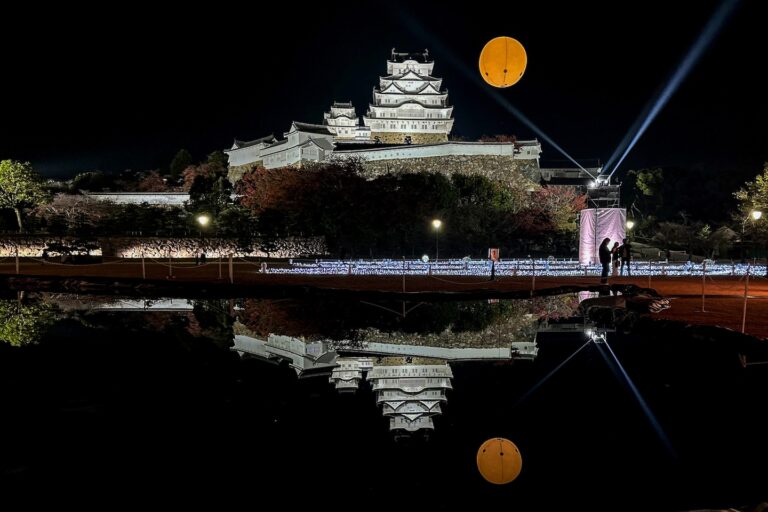Foreigners visiting Japan’s Himeji Castle may soon have to pay six times as much as domestic tourists, as the city’s mayor tries to counter a surge in tourism and a weak local currency that’s making Japan a little too attractive for tourists.
Admission to Himeji Castle, a UNESCO World Heritage Site in Hyogo Prefecture, currently costs 1,000 yen (about $7) for anyone over the age of 18. At a press conference on Sunday, Himeji Mayor Hideyasu Kiyomoto said he would like foreigners to pay $30 and local residents to pay $5, with the money to be used for castle maintenance.
Tourist taxes are nothing new — the surcharges targeted at foreign tourists are often baked into hotel receipts or visa fees. But such policies are rare in once-wealthy Japan, where the yen has fallen more than 40 percent against the U.S. dollar in the past five years, creating a stark gap in purchasing power between locals and tourists.
Public officials like Kiyomoto are not the only ones proposing dual pricing for foreigners. Some private businesses have also implemented different pricing for tourists. Last month, a seafood buffet restaurant in Tokyo made headlines when it decided to charge foreigners about 1,000 yen more for its set menu.
Get caught up in
Stories to keep you up to date
The problem isn’t tourists spending more, but too many tourists: The Washington Post reported last month that Japan is struggling with a post-COVID travel boom, with an unprecedented 25 million tourists expected to visit the country in 2023, putting a strain on locals and daily life.
“If everyone should pay their fair share, regardless of where they’re from, the argument would be that Americans should pay more so they’re ‘paying’ the same as Japanese people,” explains Dan McCall, an associate professor of tourism and sustainability at Michigan State University. “It’s easier to offer lower prices to residents than to give preferential treatment to Americans or to offer different prices for different currencies.”
Local newspaper Yomiuri Shimbun reported this week that foreign tourists will account for 30% of the 1.48 million visitors to Himeji Castle in fiscal 2023, a record high.
As visitation to cultural and natural sites increases, so does the need for restoration and maintenance, McCaul explains, and these sites often raise entrance fees to reduce visitor numbers or spend the money on investments to increase the site’s capacity.
“Charging high entrance fees for international tourists can also be seen as a social sustainability issue – the castle has cultural value to local people and they should be allowed entry,” Linda Osti, senior lecturer in tourism management at Bangor University, said.
“Secondly, this can also be seen from an economic point of view: cultural heritage sites are often maintained by local authorities using public funds collected through taxes levied on local residents,” she added. “So, in a sense, local residents are already paying for the maintenance of buildings and cultural properties. They shouldn’t be charged twice.”
The Himeji Convention and Visitors Bureau did not respond to a request for comment.
The yen’s value against the dollar has fallen over the past decade, especially sharply during the coronavirus pandemic, leading shopkeepers and restaurateurs like Shogo Yonemitsu, who opened Tamatebako in Tokyo in April, to charge foreigners more.
Yonemitsu explained to local media last month that the all-you-can-eat seafood course costs 5,980 yen for Japanese customers and 6,980 yen for foreigners, a difference of about $7.
“Considering the cost of servicing foreign tourists visiting Japan, we have no choice but to set prices high,” Yonemitsu told Nikkei Asia.
While the relative lightness of the yen may have something to do with this tiered pricing model, Rhys ap Gwillim, a senior lecturer in economics at Bangor University who co-authored the tourist tax article with Osti, believes the social and economic profile of the travellers themselves probably also plays a role.
“International tourists are probably spending a lot of money on their travels and are more likely to be wealthy than the average local person. But secondly, they may be on a once-in-a-lifetime trip and won’t be as price sensitive as a local,” Ap Gwilym explained. “For those two reasons, businesses will look at tourists, especially international tourists, and think, ‘This is an opportunity for us to charge more and they’re not going to be as price sensitive.'”
Cities including Paris and Amsterdam have also recently increased their tourist taxes, and this year Venice introduced a daily tourist fee that applies to both foreigners and non-Venetian Italians, with the explicit goal of combating overtourism.
“In the past, when enacting tourism taxes, the question was how much they could tax without losing tourists. Now, many places are not only OK with fewer tourists, but are taxing themselves to attract fewer tourists,” McCaul says. “That’s what’s new: residents of some tourist destinations are seriously challenging the ‘more is better’ philosophy, and any form of ‘tax’ could lead to fewer tourists.”

